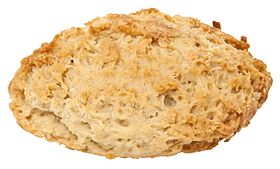Rock cake facts for kids

A rock cake made by Golden Krust bakery
|
|||||||
| Alternative names | Rock bun Scone (US) |
||||||
|---|---|---|---|---|---|---|---|
| Type | pastry | ||||||
| Place of origin | United Kingdom Ireland |
||||||
| Main ingredients | Flour, butter or margarine, sugar, egg, baking powder, water, dried fruit (currants, raisins, candied orange peel), nutmeg and mixed spices | ||||||
| 166.6 kcal (698 kJ) | |||||||
|
|||||||
A rock cake, also called a rock bun, is a small cake with a rough surface resembling a rock. They were promoted by the Ministry of Food during the Second World War since they require fewer eggs and less sugar than ordinary cakes, an important savings in a time of strict rationing. Traditional recipes bulked them with oatmeal, which was more readily available than white flour.
Recipe
Mrs Beeton's widely known 1861 recipe book includes two early recipes for rock cakes. One calls for flour, butter, 'moist sugar', lemon, milk, and baking powder. The other recipe more closely resembles shortbread, as it uses flour, butter, and currants but no leavening agent.
A typical modern recipe for 12 cakes requires about 200 g of flour, 100 g of butter or margarine, 50 g of sugar, 1 beaten egg, 1 teaspoon of baking powder, 2 tablespoons of milk, 150 g of dried fruit such as currants, raisins, candied orange peel, etc., and a pinch of nutmeg and mixed spices. Usually, flour and butter are first mixed until the mixture resembles breadcrumbs; then the other ingredients are added to create a stiff dough, which is dropped from a spoon to a baking tray or roughly formed with two forks. The cakes (optionally sprinkled with sugar and cinnamon) are baked for about 15 minutes at 200-220°C, retaining an uneven form and contour.
Variations include the Jamaican rock cake, which is similar, but usually includes grated coconut, and the traditional British rock cake, which contains oatmeal.
See also
 In Spanish: Pastel de roca para niños
In Spanish: Pastel de roca para niños

